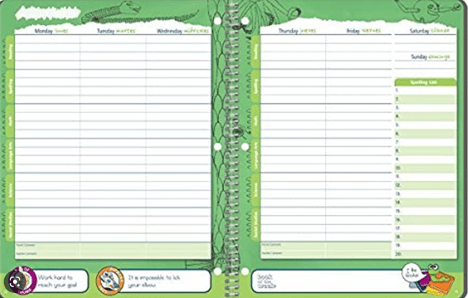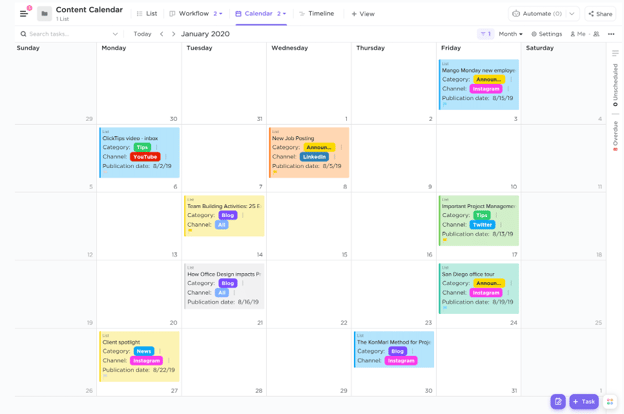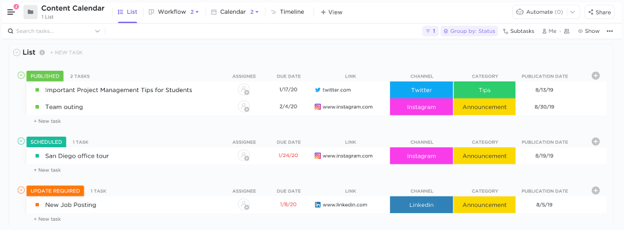Table of Contents
At the heart of content marketing lies a desire to provide valuable content that addresses customer pain points. It’s less about selling and more about building brand awareness and gaining the trust and loyalty of a target audience. This is usually done by utilizing various mediums (blogs, videos, social media posts, podcasts, etc…) across several different platforms.
Producing large amounts of content can be an exercise in organized chaos, but the key is to emphasize the “organized” part and mitigate the “chaos” portion as much as possible. That’s where a content calendar comes in handy.
Stick around to learn how 30 little squares can be the difference between consistently pumping out high quality content and randomly distributing half-hearted gobbledygook.
TL;DR: Content Calendars Keep Your Marketing Organized and On Track
-
A content calendar is a digital planner that helps teams map and manage their content
-
It includes publishing dates, topics, formats, keywords, assignees, and notes
-
Benefits include better consistency, alignment with business goals, and easier performance tracking
-
Set a sustainable publishing frequency that balances quality with capacity
-
Build calendars around key themes, mapped to audience needs and buyer journey stages
-
Use tools like ClickUp to organize by assignee, channel, and platform
-
Assign clear ownership and deadlines with built-in flexibility to adapt as things change
What is a Content Calendar?
If you went to middle or high school right around the late 90s/early 2000s you probably remember planners. These were usually handed out on the first day of school and were heralded by teachers as a way to stay organized and prepared.

Just think of a content calendar as an upgraded, digital version used by content creators and marketers to plan and organize their content creation efforts.
What Does a Content Calendar Include?
A content calendar typically includes the following information:
- Dates for when each piece of content will be published
- Topic or theme for each piece of content
- Content format (e.g. blog post, video, social media post)
- Keywords or phrases to target in the content
- Assignments for who will create and publish the content
- Notes or comments for additional information or instructions
Content calendars can be created on a weekly, monthly, or quarterly basis, depending on the needs of the business or organization. They help ensure that content is consistently published, aligned with the organization's goals and priorities, and tailored to the needs and interests of the target audience.
With content calendar tools such as ClickUp, calendars can be color-coded by assignee and social media platform (e.g. Instagram, LinkedIn)


What are the benefits of a content calendar?
If you’ve ever had the following conversation, it’s a good sign you need to be utilizing a content calendar:
(It’s 1 pm on Valentine’s day)
Marketer #1: Should we post something on social for Valentine’s Day?
Marketer #2: Maybe like a heart or something?
Marketer #1: Genius, let’s do it.
Content calendars provide a wide range of benefits including:
Consistency: Improved efficiency and organization in content creation to help avoid content gaps, build an engaged audience, and improve SEO
Alignment: Facilitates collaboration and communication among team members and stakeholders to tailor content to business goals and audience needs
Metrics: Easier tracking and measurement of content performance and ROI
How do you develop an effective content calendar?
It should be the goal of every marketing team to develop a quality content calendar each month, but what does that look like? Well, a full content calendar is usually a good thing, but the fact that it’s full doesn't automatically make it good. Here are some things to consider when putting together the calendar for the month:
Determine Publishing Frequency and Timeline
Publishing frequency is usually going to be dependent on available resources, with chief among them being employee bandwidth. With that in mind, working towards a consistent publishing schedule that can be maintained over the long-term is key (e.g. one social post a day, one blog a week) as it provides your target audience with a reliable source of information.
It’s also important not to sacrifice quality for the sake of quantity. A good way to judge this is to analyze your content performance metrics to see how often your audience engages with your content, and make the necessary adjustments.
When it comes to the timeline aspect, creating a content calendar that outlines your publishing schedule for the next several months will help you stay organized and ensure there's a steady stream of content to publish. This needs to come with the caveat that the calendar should be adaptable based on changes in your industry, audience needs, or internal resources.
Identify Content Themes and Topics
What you're creating is really all about who it’s being created for. Identifying who your target audience is and what their interests and pain points are will help in the brainstorming process. This is a great opportunity to collaborate with team members (and maybe other departments) to gather a variety of perspectives.
To get general concepts down to a more granular level, use keyword research (SEMrush FTW) and social listening tools to identify popular topics and trends related to your industry and target audience.
If you really want to go the extra mile, map out your content calendar ideas as a content journey by determining the stages of your customer's journey and develop content themes for each stage, such as awareness, consideration, and decision-making.
Organize Ideas into a Cohesive Plan
The first step here is determining what mediums you will be using (e.g. blog posts, social media posts, videos, podcasts, webinars) and choosing 2-4 overarching topics that align with your business goals and audience interests. These topics will form the basis of your content plan.
Then, divide each content pillar into subtopics and specific themes, which will help in generating ideas for individual pieces of content. As an addition to this, you can create a matrix that maps your content pillars against different content formats and topics; this will help make certain a variety of content types and themes are present throughout your content plan.
Last, but definitely, not least, don't feel like you have to reinvent the content idea wheel. You should always look to reuse and repurpose content to help maximize its impact and save time on content creation.
Assign Ownership and Deadlines
Quality content that solves customer problems is only useful if it gets published in a timely manner, or at all. Identifying who will be responsible (content creators, editors, social media managers, other team members) for creating, reviewing, approving, and publishing content is one of the most crucial steps in the content creation process.
A good first step is creating a workflow that outlines the steps involved in content creation, review, and approval. This will help make sure that everyone is clear on their responsibilities and the content creation process. Going hand-in-hand with this is the idea of assigning ownership of each piece of content to a specific team member. This will crate accountability and prevent tasks from falling through the cracks.
As far as timing is concerned, setting clear deadlines for each step in the content creation process, including ideation, drafting, review, and publishing will help ensure that content is created and published on schedule. To help with keeping everything on track, it’s a good idea to schedule regular check-ins with team members to discuss progress, address any roadblocks, and confirm everyone is on the same page.
As always, staying flexible is key because no content calendar goes 100% to plan. Be open to adjusting deadlines and ownership assignments based on changes in your industry, audience needs, or internal resources and regularly assess your workflow and make adjustments as needed.
Summing It Up
Creating quality content which provides value to your audience on a consistent basis can be an intimidating, and, at times, overwhelming task.
First, don’t panic. Second, get yourself a content calendar.
When you’re able to determine your publishing frequency and timeline, identify your content topics, organize those topics into a cohesive plan, and assign ownership and deadlines, your company will be well on its way to becoming a reliable authority in the industry.
.png)
.png)
-1.png)
.png)
